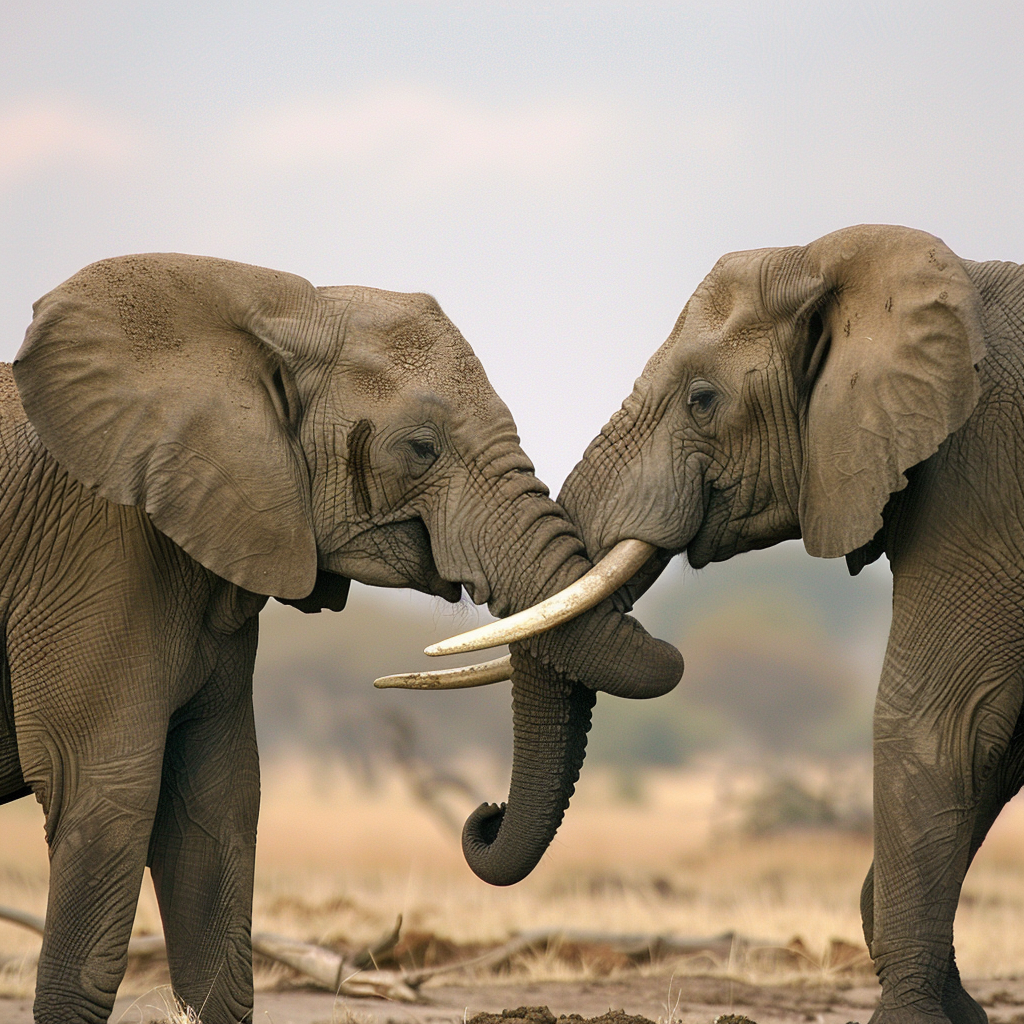
New Study Examines How Elephants Say ‘Hello’ (voanews.com)
New Study Examines How Elephants Say ‘Hello’
People greet each other in many ways. They might say “hello” in different languages. They might physically do something like shaking hands, giving hugs, or exchanging kisses.
Elephants seem to have many greetings too. A recent study gives new information about these greetings, including how greetings differ depending on the animals’ sex and whether they are looking at each other.
The study was based on observations of African savannah elephants in the Jafuta Reserve in Zimbabwe.
Vesta Eleuteri of the University of Vienna in Austria was the lead writer of the study that appeared recently in Communications Biology.
“Elephants live in a so-called ‘fission-fusion’ society, where they often separate and reunite, meeting after hours, days or months apart,” Eleuteri said.
Elephants are Earth’s largest land animals. They are highly intelligent, with strong memories and problem-solving skills, and complex communication.
Female elephants of different family groups might have strong social bonds with each other, forming “bond groups.” Earlier studies in the wild have reported that when these groups meet, the elephants perform special greeting ceremonies to announce and strengthen their social bonds, Eleuteri said.
Male elephants have different social bonds from females. Male greetings may serve to ease possible hostility. Male elephants greet mainly by smelling each other, reaching with their trunks, Eleuteri added.
The recent study gives details on around 20 movements tied to greetings. It showed that elephants mix these movements in exact ways with sounds. The different sounds are described as rumbles, roars and trumpets.
The study also showed how smell plays an important part in greetings. Elephant greetings include behaviors unusual for humans, including releasing body waste. Elephants can also release secretions from a special gland.
Elephants may greet each other by making gestures meant to be seen, like spreading their ears or showing their behinds. The creatures also use movements producing special sounds, or they may use movements that involve touching other elephants. Movements involving touching are known as tactile gestures.
Eleuteri suggested that elephants appeared to know what other elephants can see. “They preferred using visual gestures when their partner was looking at them, while tactile ones when they were not,” Eleuteri explained.
Greeting behavior has been studied in a number of animals.
“Many other species greet, including different primates, hyenas and dogs,” Eleuteri said.
These animal greetings help guide social situations by reducing tension or confirming social bonds, Eleuteri added.
The new research builds on earlier studies of elephant greeting behavior. The nine observed elephants – four females and five males – were “semi-captive.” That means they freely moved around their natural environment during daytime and stayed in structures at night.
Greetings used by the female elephants closely matched the behavior of wild elephants. The greeting behavior of the male elephants appeared to be different from wild male elephants.
Wild male elephants are often alone, forming loose connections with other elephants.
The temporal gland is midway between the eye and the ear. That gland plays a part in elephant greeting by releasing a substance called temporin. Temporin contains chemical information about an elephant’s condition. Elephants often use their trunks to touch the temporal glands of others.
Eleuteri said elephant body wastes “contain chemical information important for elephants, like the identity of the individual, their reproductive state or even their emotional state.”
“Maybe they don’t need to tell each other how they’re doing, as they can smell it,” Eleuteri added.
【日本語訳】
象がどのように「こんにちは」と言うかを調べた新しい研究
人々はさまざまな方法でお互いに挨拶をします。彼らは異なる言語で「こんにちは」と言うかもしれません。握手、ハグ、キスなどの身体的な行動をとるかもしれません。
象にもたくさんの挨拶があるようです。最近の研究では、これらの挨拶について新しい情報が得られました。動物の性別や、お互いを見ているかどうかによって、挨拶がどのように異なるかについてです。
この研究は、ジンバブエのジャフタ保護区でのアフリカのサバンナ象の観察に基づいています。
オーストリアのウィーン大学のヴェスタ・エレウテリ氏が、最近「Communications Biology」誌に掲載された研究の主執筆者です。
「象は、いわゆる『分離と融合』の社会に生きています。象たちはしばしば分かれてまた再会し、数時間、数日、あるいは数ヶ月離れた後に会うのです」とエレウテリ氏は言いました。
象は地球上で最大の陸上動物です。高い知能を持ち、強い記憶力と問題解決能力、そして複雑なコミュニケーション能力を持っています。
異なる家族グループの雌象は、お互いに強い社会的絆を持ち、「絆グループ」を形成することがあります。野生での以前の研究では、これらのグループが出会った時、象たちは特別な挨拶の儀式を行って、社会的な絆を告げ、強めることが報告されている、とエレウテリ氏は述べました。
雄象は雌象とは異なる社会的絆を持っています。雄象の挨拶は、敵対心を和らげる役割を果たしているのかもしれません。雄象は主に、鼻を伸ばしてお互いの匂いを嗅ぐことで挨拶をします、とエレウテリ氏は付け加えました。
最近の研究では、挨拶に関連する約20の動作の詳細が示されました。象がこれらの動作を音と正確に組み合わせていることが示されたのです。その異なる音は、ゴロゴロ、咆哮、ラッパのような音として説明されています。
この研究はまた、におい嗅ぎが挨拶の重要な部分を占めていることを示しました。象の挨拶には、人間にとっては珍しい行動が含まれています。例えば、体の老廃物を出すことです。象は特別な腺から分泌液を出すこともできます。
象は、耳を広げたり、お尻を見せたりするなど、見せるためのジェスチャーで挨拶することがあります。特別な音を出す動きを使ったり、他の象に触れる動きを使ったりもします。触れることを含む動作は、触覚的なジェスチャーとして知られています。
エレウテリ氏は、象は他の象が何を見ているのかを知っているように思えると示唆しました。「彼らは、パートナーが自分を見ている時には視覚的なジェスチャーを、見ていない時には触覚的なジェスチャーを好んで使っていました」とエレウテリ氏は説明しました。
挨拶行動は多くの動物で研究されてきました。
「多くの他の種が挨拶をします。さまざまな霊長類、ハイエナ、犬などです」とエレウテリ氏は言いました。
これらの動物の挨拶は、緊張を和らげたり、社会的な絆を確認したりすることで、社会的状況を導く役割を果たしている、とエレウテリ氏は付け加えました。
この新しい研究は、象の挨拶行動に関する以前の研究を発展させたものです。観察された9頭の象(雌4頭、雄5頭)は「半飼育」状態にありました。つまり、昼間は自然環境の中を自由に移動し、夜は建物の中で過ごしていたのです。
雌象が使った挨拶は、野生の象の行動と密接に一致していました。一方、雄象の挨拶行動は、野生の雄象とは異なっているようでした。
野生の雄象はしばしば単独で、他の象とのゆるやかなつながりを形成しています。
側頭腺は目と耳の中間にあります。この腺は、テンポリンと呼ばれる物質を放出することで、象の挨拶に関与しています。テンポリンには、象の状態に関する化学的な情報が含まれています。象はしばしば鼻を使って、他の象の側頭腺に触れます。
エレウテリ氏は、象の体の老廃物には、「個体の同一性、生殖状態、さらには感情状態など、象にとって重要な化学的情報が含まれている」と述べました。
「おそらく彼らは、お互いの状態を伝える必要がないのでしょう。匂いでわかるのですから」とエレウテリ氏は付け加えました。
単語・熟語チェック
・fission-fusion 分裂・融合
・social bonds 社会的絆
・hostility 敵意
・rumbles うなり声
・roars 咆哮
・trumpets ラッパ音
・secretions 分泌物
・gland 腺
・gestures 身振り
・tactile 触覚の
・primates 霊長類
・hyenas ハイエナ
・semi-captive 半飼育の
・temporal gland 側頭腺
・temporin テンポリン
単語解説
・fission-fusion
⇒分裂と融合を繰り返す社会構造を指す。群れが小さなグループに分かれたり、再び合流したりすることを表す生態学の用語。
・social bonds
⇒社会的な絆や結びつきのこと。個体間の親密な関係性を表す。
・hostility
⇒敵意、敵対心、反感などの意味を持つ名詞。形容詞のhostileは「敵対的な、非友好的な」という意味。
・rumbles
⇒ゾウの発する低い唸り声を指す。動詞のrumbleは「轟音を立てる、唸る」などの意味がある。
・roars
⇒大きな咆哮や吠え声のこと。ライオンの吠え声なども指す。動詞のroarは「咆哮する、吠える」という意味。
・trumpets
⇒ゾウの鳴き声の一種で、ラッパのような高い音を指す。
・secretions
⇒腺などから分泌される液体を指す名詞。動詞のsecreteは「分泌する」という意味。
・gland
⇒分泌腺、腺組織のこと。ホルモンや他の物質を分泌する器官。
・gestures
⇒身振り、ジェスチャー、しぐさなどを表す名詞。
・tactile
⇒触覚の、触れることに関する、という意味の形容詞。名詞形はtactility。
・primates
⇒霊長類のこと。ヒトを含む、類人猿や猿などの総称。
・hyenas
⇒ハイエナのこと。アフリカなどに生息する哺乳類の肉食動物。
・semi-captive
⇒半飼育の、半野生の状態を表す形容詞。
・temporal gland
⇒側頭腺のこと。ゾウの目と耳の間にある分泌腺で、フェロモンを分泌することが知られている。
・temporin
⇒側頭腺から分泌される物質の名称。フェロモンの一種と考えられている。
この記事は、アフリカゾウの挨拶行動に関する最新の研究結果を紹介しています。主な内容は以下の通りです。
1. アフリカゾウは、群れを離れたり再会したりする「分裂・融合社会」を形成しており、再会時には特別な挨拶儀式を行う。
2. メスゾウは強い社会的絆を持ち、「絆グループ」を形成する。一方、オスゾウの挨拶は敵意を和らげる役割がある。
3. 研究では、約20種類の挨拶動作が詳細に観察され、それらが特定の方法で音声と組み合わされていることが明らかになった。
4. 匂いも挨拶において重要な役割を果たしており、排泄物や特殊腺からの分泌物が利用される。
5. ゾウは相手が自分を見ているかどうかを認識しており、視覚的ジェスチャーと触覚的ジェスチャーを使い分けている。
6. 観察された飼育下のメスゾウの挨拶行動は野生のゾウと類似していたが、オスゾウの行動は野生のものとは異なっていた。
7. 側頭腺から分泌されるテンポリンには、ゾウの状態に関する化学情報が含まれている。
この研究は、ゾウの高度な知性とコミュニケーション能力を示すとともに、社会的絆を強化するための挨拶行動の重要性を浮き彫りにしています。また、ゾウが視覚や嗅覚などの感覚を巧みに利用して情報をやり取りしていることも明らかになりました。






